Union Effects on Performance and Employment Relations
VerifiedAdded on 2021/06/17
|11
|3675
|37
AI Summary
Contribute Materials
Your contribution can guide someone’s learning journey. Share your
documents today.
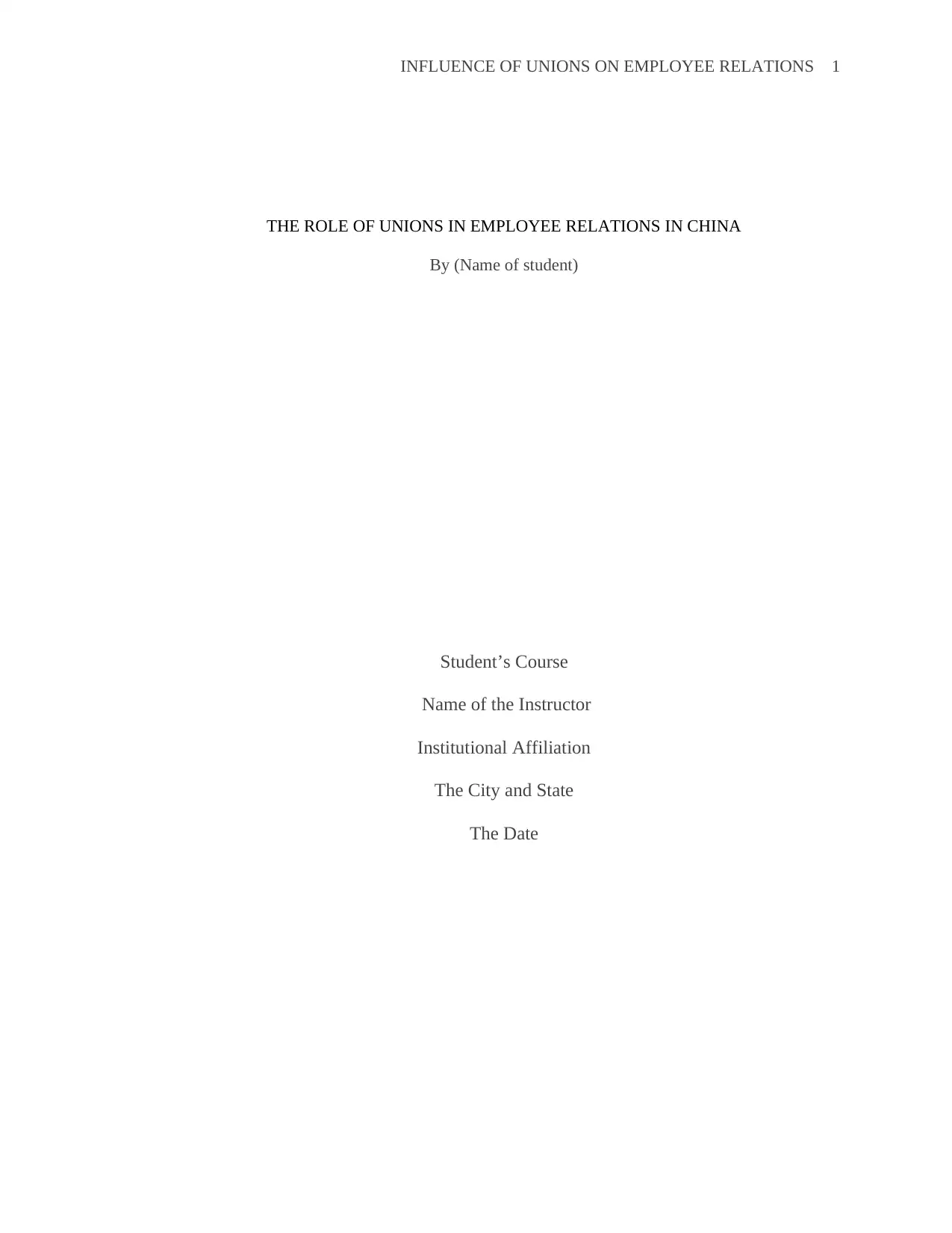
INFLUENCE OF UNIONS ON EMPLOYEE RELATIONS 1
THE ROLE OF UNIONS IN EMPLOYEE RELATIONS IN CHINA
By (Name of student)
Student’s Course
Name of the Instructor
Institutional Affiliation
The City and State
The Date
THE ROLE OF UNIONS IN EMPLOYEE RELATIONS IN CHINA
By (Name of student)
Student’s Course
Name of the Instructor
Institutional Affiliation
The City and State
The Date
Secure Best Marks with AI Grader
Need help grading? Try our AI Grader for instant feedback on your assignments.
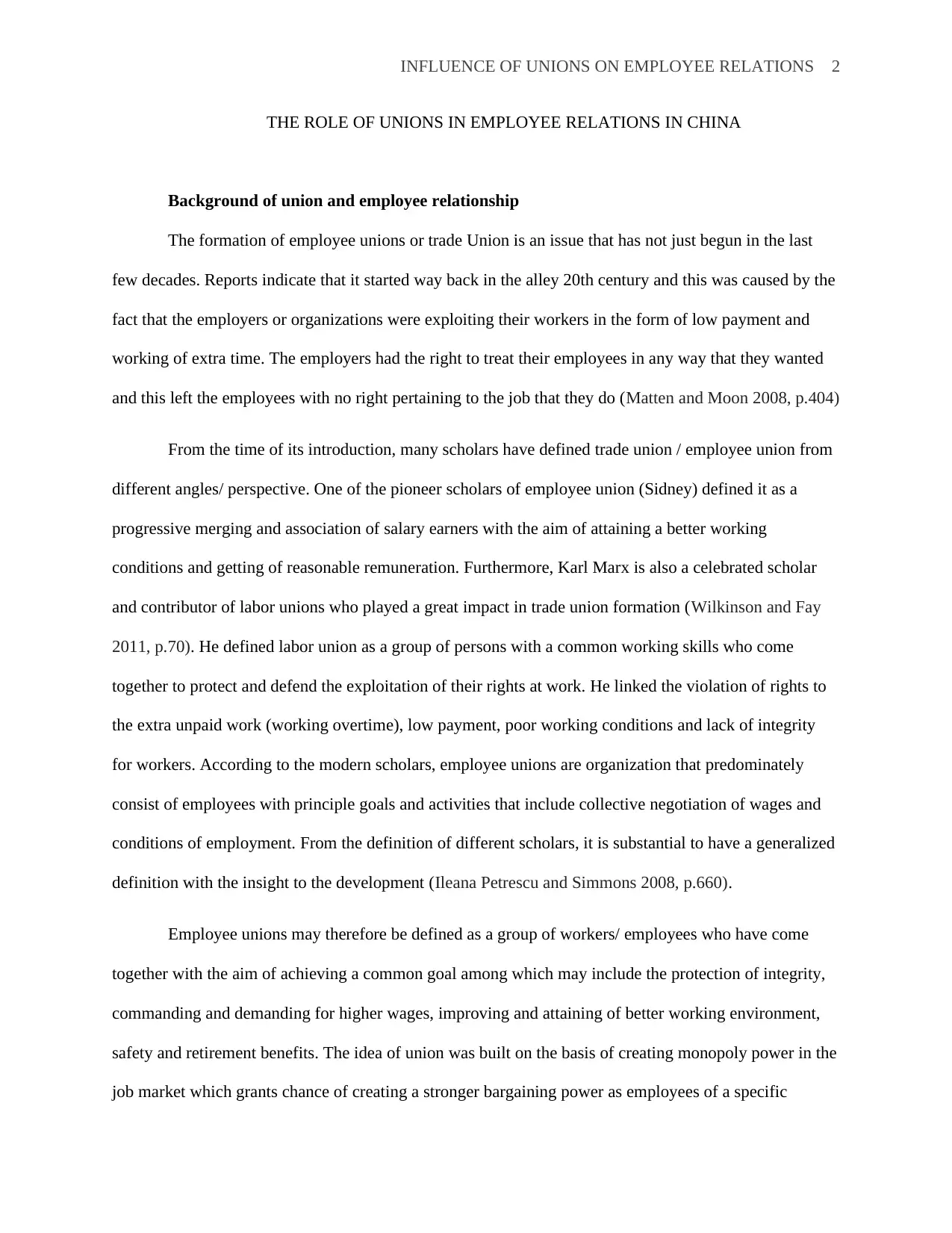
INFLUENCE OF UNIONS ON EMPLOYEE RELATIONS 2
THE ROLE OF UNIONS IN EMPLOYEE RELATIONS IN CHINA
Background of union and employee relationship
The formation of employee unions or trade Union is an issue that has not just begun in the last
few decades. Reports indicate that it started way back in the alley 20th century and this was caused by the
fact that the employers or organizations were exploiting their workers in the form of low payment and
working of extra time. The employers had the right to treat their employees in any way that they wanted
and this left the employees with no right pertaining to the job that they do (Matten and Moon 2008, p.404)
From the time of its introduction, many scholars have defined trade union / employee union from
different angles/ perspective. One of the pioneer scholars of employee union (Sidney) defined it as a
progressive merging and association of salary earners with the aim of attaining a better working
conditions and getting of reasonable remuneration. Furthermore, Karl Marx is also a celebrated scholar
and contributor of labor unions who played a great impact in trade union formation (Wilkinson and Fay
2011, p.70). He defined labor union as a group of persons with a common working skills who come
together to protect and defend the exploitation of their rights at work. He linked the violation of rights to
the extra unpaid work (working overtime), low payment, poor working conditions and lack of integrity
for workers. According to the modern scholars, employee unions are organization that predominately
consist of employees with principle goals and activities that include collective negotiation of wages and
conditions of employment. From the definition of different scholars, it is substantial to have a generalized
definition with the insight to the development (Ileana Petrescu and Simmons 2008, p.660).
Employee unions may therefore be defined as a group of workers/ employees who have come
together with the aim of achieving a common goal among which may include the protection of integrity,
commanding and demanding for higher wages, improving and attaining of better working environment,
safety and retirement benefits. The idea of union was built on the basis of creating monopoly power in the
job market which grants chance of creating a stronger bargaining power as employees of a specific
THE ROLE OF UNIONS IN EMPLOYEE RELATIONS IN CHINA
Background of union and employee relationship
The formation of employee unions or trade Union is an issue that has not just begun in the last
few decades. Reports indicate that it started way back in the alley 20th century and this was caused by the
fact that the employers or organizations were exploiting their workers in the form of low payment and
working of extra time. The employers had the right to treat their employees in any way that they wanted
and this left the employees with no right pertaining to the job that they do (Matten and Moon 2008, p.404)
From the time of its introduction, many scholars have defined trade union / employee union from
different angles/ perspective. One of the pioneer scholars of employee union (Sidney) defined it as a
progressive merging and association of salary earners with the aim of attaining a better working
conditions and getting of reasonable remuneration. Furthermore, Karl Marx is also a celebrated scholar
and contributor of labor unions who played a great impact in trade union formation (Wilkinson and Fay
2011, p.70). He defined labor union as a group of persons with a common working skills who come
together to protect and defend the exploitation of their rights at work. He linked the violation of rights to
the extra unpaid work (working overtime), low payment, poor working conditions and lack of integrity
for workers. According to the modern scholars, employee unions are organization that predominately
consist of employees with principle goals and activities that include collective negotiation of wages and
conditions of employment. From the definition of different scholars, it is substantial to have a generalized
definition with the insight to the development (Ileana Petrescu and Simmons 2008, p.660).
Employee unions may therefore be defined as a group of workers/ employees who have come
together with the aim of achieving a common goal among which may include the protection of integrity,
commanding and demanding for higher wages, improving and attaining of better working environment,
safety and retirement benefits. The idea of union was built on the basis of creating monopoly power in the
job market which grants chance of creating a stronger bargaining power as employees of a specific
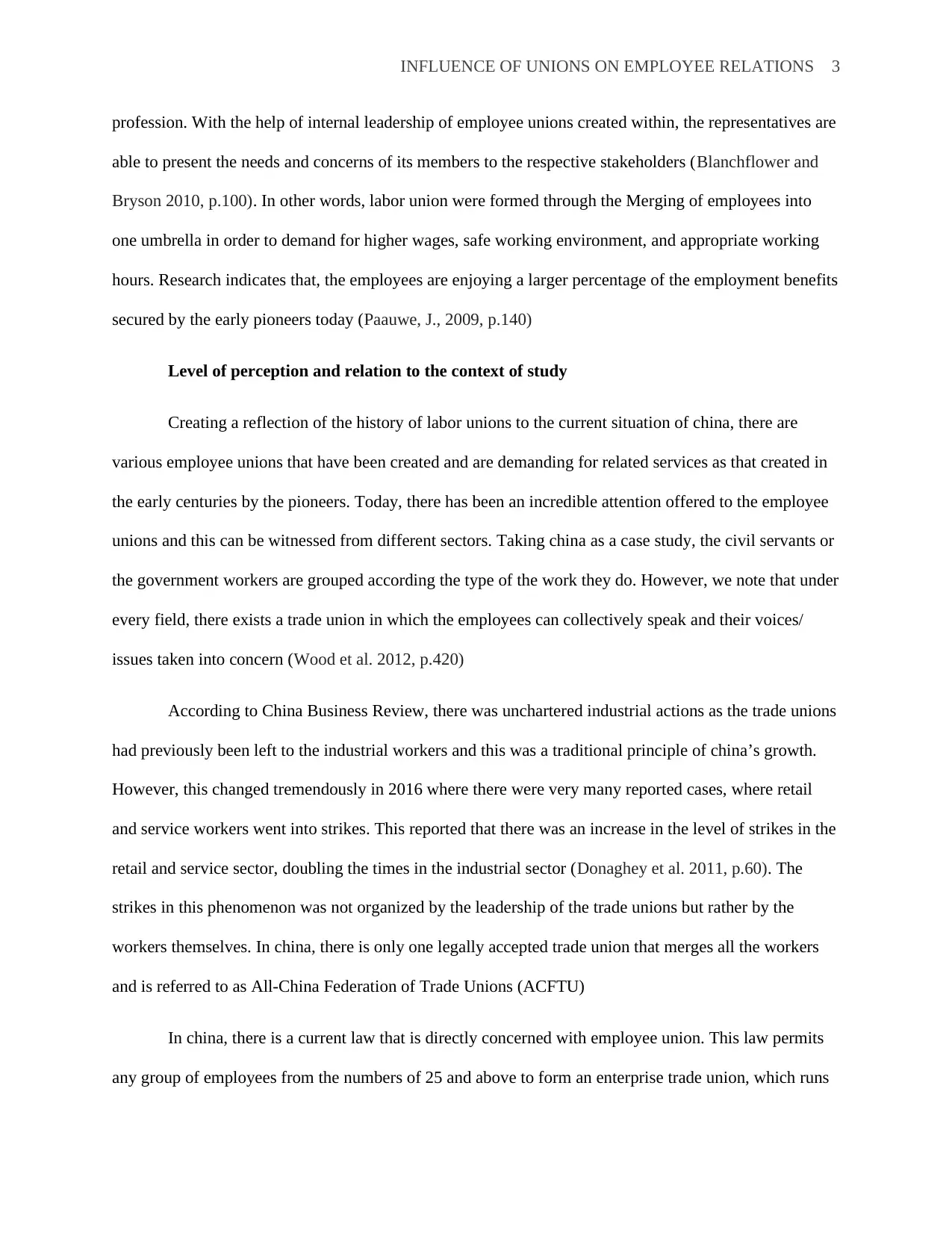
INFLUENCE OF UNIONS ON EMPLOYEE RELATIONS 3
profession. With the help of internal leadership of employee unions created within, the representatives are
able to present the needs and concerns of its members to the respective stakeholders (Blanchflower and
Bryson 2010, p.100). In other words, labor union were formed through the Merging of employees into
one umbrella in order to demand for higher wages, safe working environment, and appropriate working
hours. Research indicates that, the employees are enjoying a larger percentage of the employment benefits
secured by the early pioneers today (Paauwe, J., 2009, p.140)
Level of perception and relation to the context of study
Creating a reflection of the history of labor unions to the current situation of china, there are
various employee unions that have been created and are demanding for related services as that created in
the early centuries by the pioneers. Today, there has been an incredible attention offered to the employee
unions and this can be witnessed from different sectors. Taking china as a case study, the civil servants or
the government workers are grouped according the type of the work they do. However, we note that under
every field, there exists a trade union in which the employees can collectively speak and their voices/
issues taken into concern (Wood et al. 2012, p.420)
According to China Business Review, there was unchartered industrial actions as the trade unions
had previously been left to the industrial workers and this was a traditional principle of china’s growth.
However, this changed tremendously in 2016 where there were very many reported cases, where retail
and service workers went into strikes. This reported that there was an increase in the level of strikes in the
retail and service sector, doubling the times in the industrial sector (Donaghey et al. 2011, p.60). The
strikes in this phenomenon was not organized by the leadership of the trade unions but rather by the
workers themselves. In china, there is only one legally accepted trade union that merges all the workers
and is referred to as All-China Federation of Trade Unions (ACFTU)
In china, there is a current law that is directly concerned with employee union. This law permits
any group of employees from the numbers of 25 and above to form an enterprise trade union, which runs
profession. With the help of internal leadership of employee unions created within, the representatives are
able to present the needs and concerns of its members to the respective stakeholders (Blanchflower and
Bryson 2010, p.100). In other words, labor union were formed through the Merging of employees into
one umbrella in order to demand for higher wages, safe working environment, and appropriate working
hours. Research indicates that, the employees are enjoying a larger percentage of the employment benefits
secured by the early pioneers today (Paauwe, J., 2009, p.140)
Level of perception and relation to the context of study
Creating a reflection of the history of labor unions to the current situation of china, there are
various employee unions that have been created and are demanding for related services as that created in
the early centuries by the pioneers. Today, there has been an incredible attention offered to the employee
unions and this can be witnessed from different sectors. Taking china as a case study, the civil servants or
the government workers are grouped according the type of the work they do. However, we note that under
every field, there exists a trade union in which the employees can collectively speak and their voices/
issues taken into concern (Wood et al. 2012, p.420)
According to China Business Review, there was unchartered industrial actions as the trade unions
had previously been left to the industrial workers and this was a traditional principle of china’s growth.
However, this changed tremendously in 2016 where there were very many reported cases, where retail
and service workers went into strikes. This reported that there was an increase in the level of strikes in the
retail and service sector, doubling the times in the industrial sector (Donaghey et al. 2011, p.60). The
strikes in this phenomenon was not organized by the leadership of the trade unions but rather by the
workers themselves. In china, there is only one legally accepted trade union that merges all the workers
and is referred to as All-China Federation of Trade Unions (ACFTU)
In china, there is a current law that is directly concerned with employee union. This law permits
any group of employees from the numbers of 25 and above to form an enterprise trade union, which runs
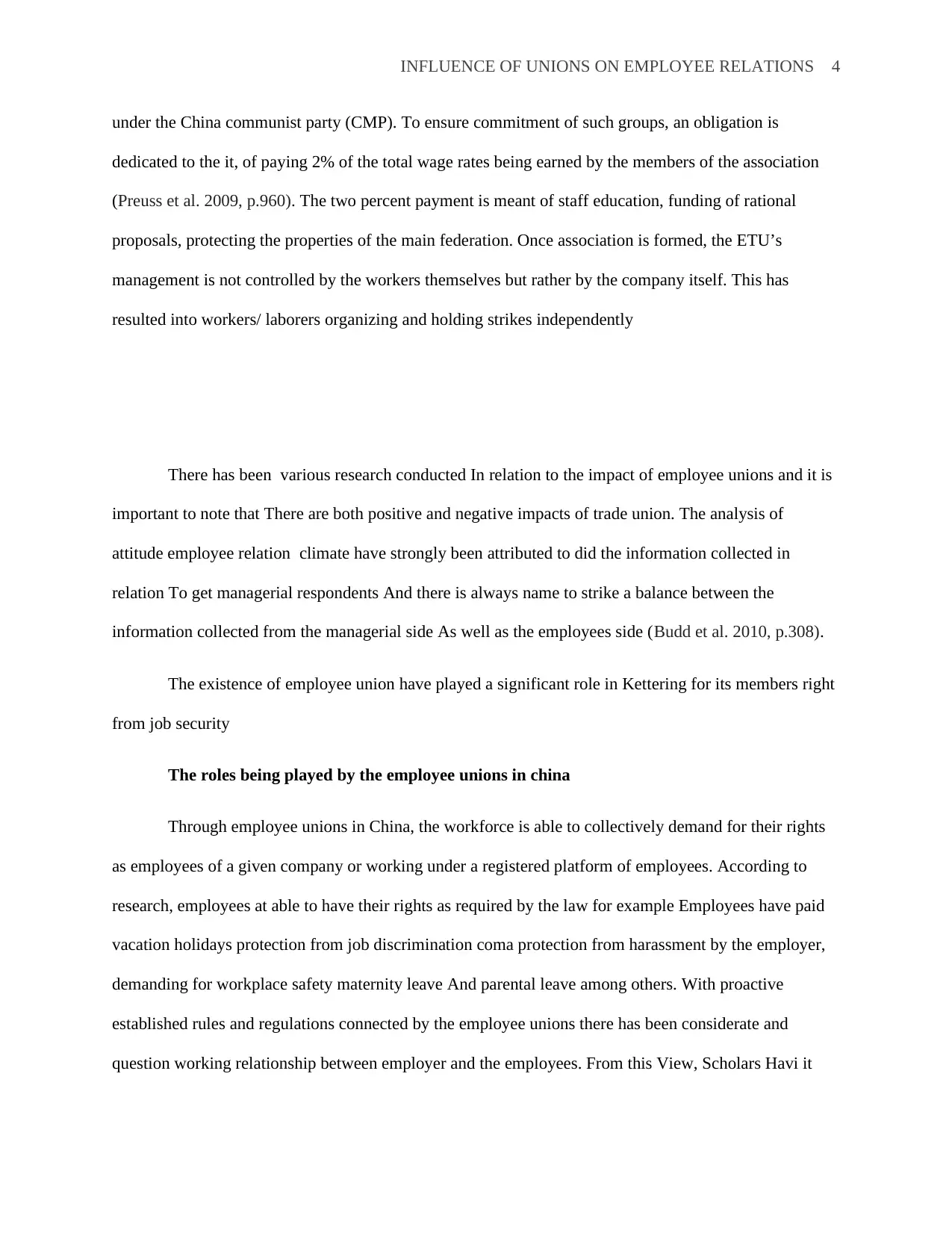
INFLUENCE OF UNIONS ON EMPLOYEE RELATIONS 4
under the China communist party (CMP). To ensure commitment of such groups, an obligation is
dedicated to the it, of paying 2% of the total wage rates being earned by the members of the association
(Preuss et al. 2009, p.960). The two percent payment is meant of staff education, funding of rational
proposals, protecting the properties of the main federation. Once association is formed, the ETU’s
management is not controlled by the workers themselves but rather by the company itself. This has
resulted into workers/ laborers organizing and holding strikes independently
There has been various research conducted In relation to the impact of employee unions and it is
important to note that There are both positive and negative impacts of trade union. The analysis of
attitude employee relation climate have strongly been attributed to did the information collected in
relation To get managerial respondents And there is always name to strike a balance between the
information collected from the managerial side As well as the employees side (Budd et al. 2010, p.308).
The existence of employee union have played a significant role in Kettering for its members right
from job security
The roles being played by the employee unions in china
Through employee unions in China, the workforce is able to collectively demand for their rights
as employees of a given company or working under a registered platform of employees. According to
research, employees at able to have their rights as required by the law for example Employees have paid
vacation holidays protection from job discrimination coma protection from harassment by the employer,
demanding for workplace safety maternity leave And parental leave among others. With proactive
established rules and regulations connected by the employee unions there has been considerate and
question working relationship between employer and the employees. From this View, Scholars Havi it
under the China communist party (CMP). To ensure commitment of such groups, an obligation is
dedicated to the it, of paying 2% of the total wage rates being earned by the members of the association
(Preuss et al. 2009, p.960). The two percent payment is meant of staff education, funding of rational
proposals, protecting the properties of the main federation. Once association is formed, the ETU’s
management is not controlled by the workers themselves but rather by the company itself. This has
resulted into workers/ laborers organizing and holding strikes independently
There has been various research conducted In relation to the impact of employee unions and it is
important to note that There are both positive and negative impacts of trade union. The analysis of
attitude employee relation climate have strongly been attributed to did the information collected in
relation To get managerial respondents And there is always name to strike a balance between the
information collected from the managerial side As well as the employees side (Budd et al. 2010, p.308).
The existence of employee union have played a significant role in Kettering for its members right
from job security
The roles being played by the employee unions in china
Through employee unions in China, the workforce is able to collectively demand for their rights
as employees of a given company or working under a registered platform of employees. According to
research, employees at able to have their rights as required by the law for example Employees have paid
vacation holidays protection from job discrimination coma protection from harassment by the employer,
demanding for workplace safety maternity leave And parental leave among others. With proactive
established rules and regulations connected by the employee unions there has been considerate and
question working relationship between employer and the employees. From this View, Scholars Havi it
Secure Best Marks with AI Grader
Need help grading? Try our AI Grader for instant feedback on your assignments.
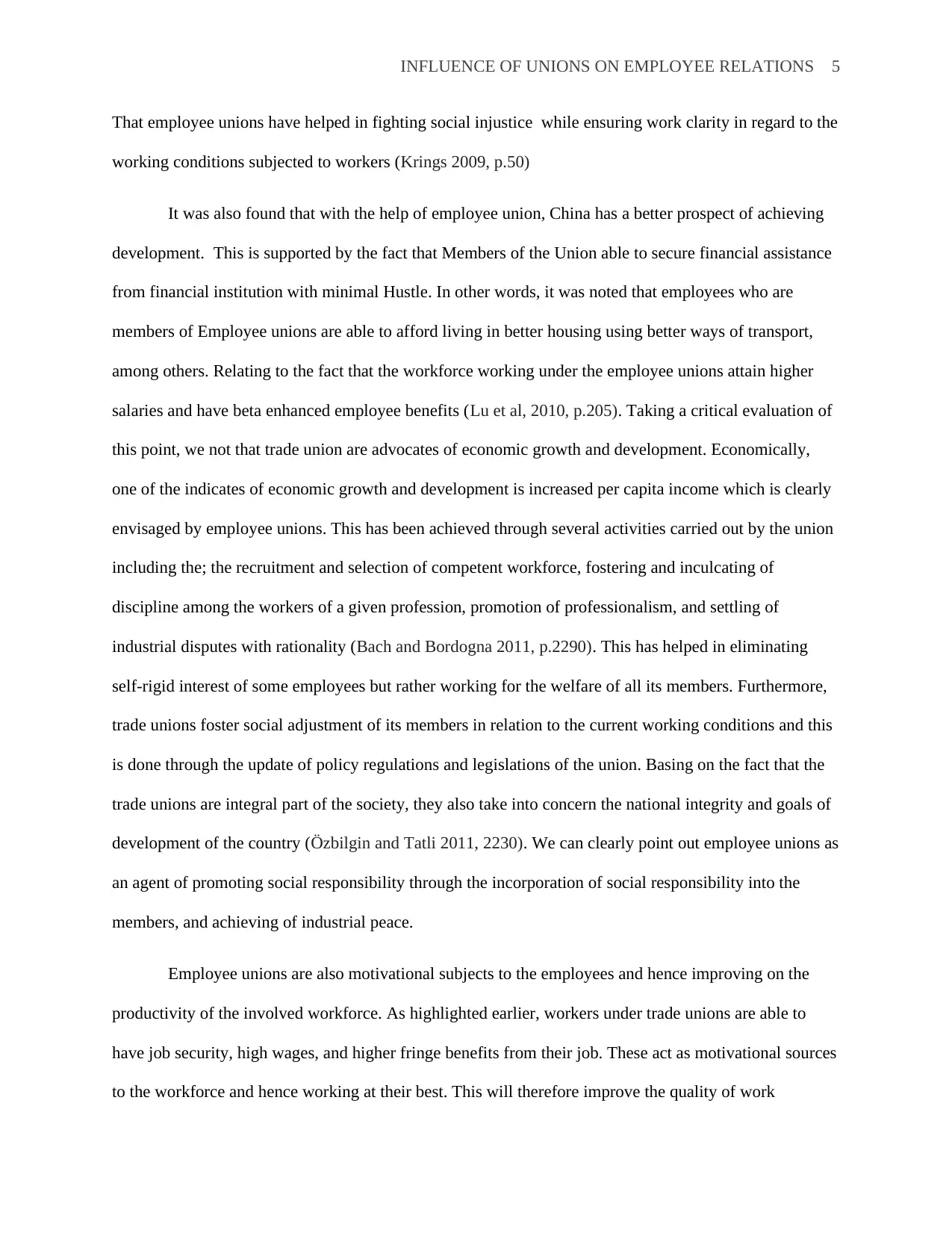
INFLUENCE OF UNIONS ON EMPLOYEE RELATIONS 5
That employee unions have helped in fighting social injustice while ensuring work clarity in regard to the
working conditions subjected to workers (Krings 2009, p.50)
It was also found that with the help of employee union, China has a better prospect of achieving
development. This is supported by the fact that Members of the Union able to secure financial assistance
from financial institution with minimal Hustle. In other words, it was noted that employees who are
members of Employee unions are able to afford living in better housing using better ways of transport,
among others. Relating to the fact that the workforce working under the employee unions attain higher
salaries and have beta enhanced employee benefits (Lu et al, 2010, p.205). Taking a critical evaluation of
this point, we not that trade union are advocates of economic growth and development. Economically,
one of the indicates of economic growth and development is increased per capita income which is clearly
envisaged by employee unions. This has been achieved through several activities carried out by the union
including the; the recruitment and selection of competent workforce, fostering and inculcating of
discipline among the workers of a given profession, promotion of professionalism, and settling of
industrial disputes with rationality (Bach and Bordogna 2011, p.2290). This has helped in eliminating
self-rigid interest of some employees but rather working for the welfare of all its members. Furthermore,
trade unions foster social adjustment of its members in relation to the current working conditions and this
is done through the update of policy regulations and legislations of the union. Basing on the fact that the
trade unions are integral part of the society, they also take into concern the national integrity and goals of
development of the country (Özbilgin and Tatli 2011, 2230). We can clearly point out employee unions as
an agent of promoting social responsibility through the incorporation of social responsibility into the
members, and achieving of industrial peace.
Employee unions are also motivational subjects to the employees and hence improving on the
productivity of the involved workforce. As highlighted earlier, workers under trade unions are able to
have job security, high wages, and higher fringe benefits from their job. These act as motivational sources
to the workforce and hence working at their best. This will therefore improve the quality of work
That employee unions have helped in fighting social injustice while ensuring work clarity in regard to the
working conditions subjected to workers (Krings 2009, p.50)
It was also found that with the help of employee union, China has a better prospect of achieving
development. This is supported by the fact that Members of the Union able to secure financial assistance
from financial institution with minimal Hustle. In other words, it was noted that employees who are
members of Employee unions are able to afford living in better housing using better ways of transport,
among others. Relating to the fact that the workforce working under the employee unions attain higher
salaries and have beta enhanced employee benefits (Lu et al, 2010, p.205). Taking a critical evaluation of
this point, we not that trade union are advocates of economic growth and development. Economically,
one of the indicates of economic growth and development is increased per capita income which is clearly
envisaged by employee unions. This has been achieved through several activities carried out by the union
including the; the recruitment and selection of competent workforce, fostering and inculcating of
discipline among the workers of a given profession, promotion of professionalism, and settling of
industrial disputes with rationality (Bach and Bordogna 2011, p.2290). This has helped in eliminating
self-rigid interest of some employees but rather working for the welfare of all its members. Furthermore,
trade unions foster social adjustment of its members in relation to the current working conditions and this
is done through the update of policy regulations and legislations of the union. Basing on the fact that the
trade unions are integral part of the society, they also take into concern the national integrity and goals of
development of the country (Özbilgin and Tatli 2011, 2230). We can clearly point out employee unions as
an agent of promoting social responsibility through the incorporation of social responsibility into the
members, and achieving of industrial peace.
Employee unions are also motivational subjects to the employees and hence improving on the
productivity of the involved workforce. As highlighted earlier, workers under trade unions are able to
have job security, high wages, and higher fringe benefits from their job. These act as motivational sources
to the workforce and hence working at their best. This will therefore improve the quality of work
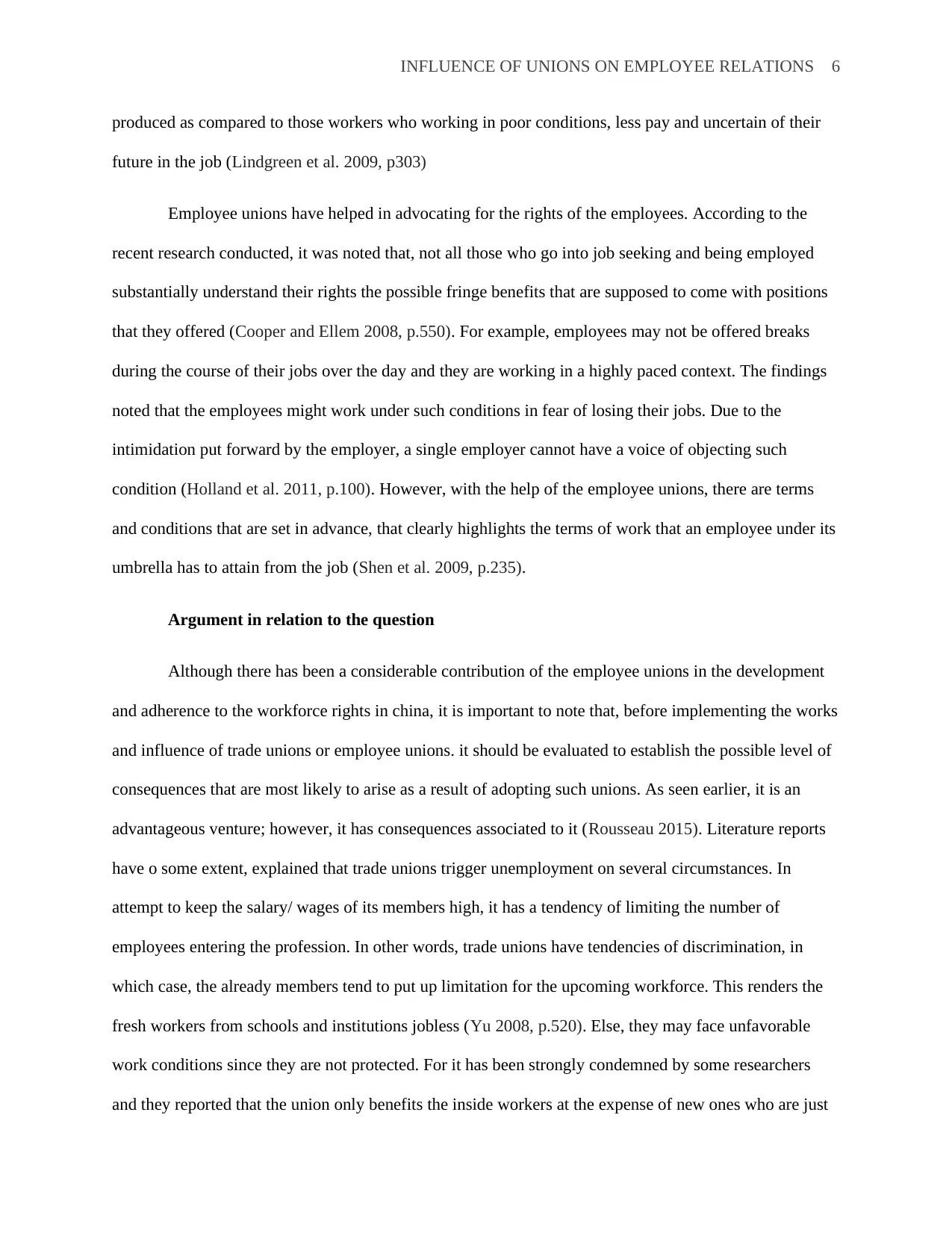
INFLUENCE OF UNIONS ON EMPLOYEE RELATIONS 6
produced as compared to those workers who working in poor conditions, less pay and uncertain of their
future in the job (Lindgreen et al. 2009, p303)
Employee unions have helped in advocating for the rights of the employees. According to the
recent research conducted, it was noted that, not all those who go into job seeking and being employed
substantially understand their rights the possible fringe benefits that are supposed to come with positions
that they offered (Cooper and Ellem 2008, p.550). For example, employees may not be offered breaks
during the course of their jobs over the day and they are working in a highly paced context. The findings
noted that the employees might work under such conditions in fear of losing their jobs. Due to the
intimidation put forward by the employer, a single employer cannot have a voice of objecting such
condition (Holland et al. 2011, p.100). However, with the help of the employee unions, there are terms
and conditions that are set in advance, that clearly highlights the terms of work that an employee under its
umbrella has to attain from the job (Shen et al. 2009, p.235).
Argument in relation to the question
Although there has been a considerable contribution of the employee unions in the development
and adherence to the workforce rights in china, it is important to note that, before implementing the works
and influence of trade unions or employee unions. it should be evaluated to establish the possible level of
consequences that are most likely to arise as a result of adopting such unions. As seen earlier, it is an
advantageous venture; however, it has consequences associated to it (Rousseau 2015). Literature reports
have o some extent, explained that trade unions trigger unemployment on several circumstances. In
attempt to keep the salary/ wages of its members high, it has a tendency of limiting the number of
employees entering the profession. In other words, trade unions have tendencies of discrimination, in
which case, the already members tend to put up limitation for the upcoming workforce. This renders the
fresh workers from schools and institutions jobless (Yu 2008, p.520). Else, they may face unfavorable
work conditions since they are not protected. For it has been strongly condemned by some researchers
and they reported that the union only benefits the inside workers at the expense of new ones who are just
produced as compared to those workers who working in poor conditions, less pay and uncertain of their
future in the job (Lindgreen et al. 2009, p303)
Employee unions have helped in advocating for the rights of the employees. According to the
recent research conducted, it was noted that, not all those who go into job seeking and being employed
substantially understand their rights the possible fringe benefits that are supposed to come with positions
that they offered (Cooper and Ellem 2008, p.550). For example, employees may not be offered breaks
during the course of their jobs over the day and they are working in a highly paced context. The findings
noted that the employees might work under such conditions in fear of losing their jobs. Due to the
intimidation put forward by the employer, a single employer cannot have a voice of objecting such
condition (Holland et al. 2011, p.100). However, with the help of the employee unions, there are terms
and conditions that are set in advance, that clearly highlights the terms of work that an employee under its
umbrella has to attain from the job (Shen et al. 2009, p.235).
Argument in relation to the question
Although there has been a considerable contribution of the employee unions in the development
and adherence to the workforce rights in china, it is important to note that, before implementing the works
and influence of trade unions or employee unions. it should be evaluated to establish the possible level of
consequences that are most likely to arise as a result of adopting such unions. As seen earlier, it is an
advantageous venture; however, it has consequences associated to it (Rousseau 2015). Literature reports
have o some extent, explained that trade unions trigger unemployment on several circumstances. In
attempt to keep the salary/ wages of its members high, it has a tendency of limiting the number of
employees entering the profession. In other words, trade unions have tendencies of discrimination, in
which case, the already members tend to put up limitation for the upcoming workforce. This renders the
fresh workers from schools and institutions jobless (Yu 2008, p.520). Else, they may face unfavorable
work conditions since they are not protected. For it has been strongly condemned by some researchers
and they reported that the union only benefits the inside workers at the expense of new ones who are just
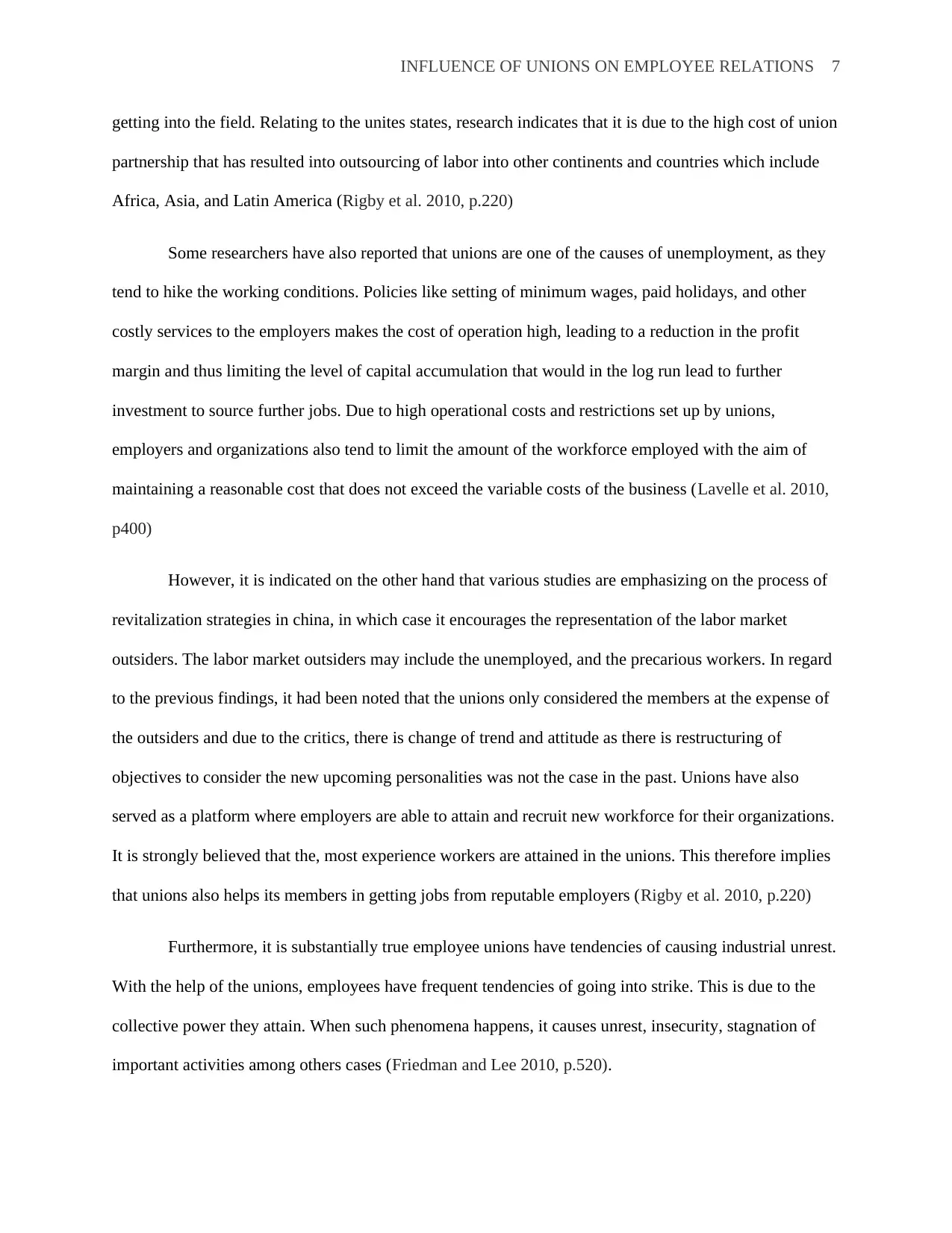
INFLUENCE OF UNIONS ON EMPLOYEE RELATIONS 7
getting into the field. Relating to the unites states, research indicates that it is due to the high cost of union
partnership that has resulted into outsourcing of labor into other continents and countries which include
Africa, Asia, and Latin America (Rigby et al. 2010, p.220)
Some researchers have also reported that unions are one of the causes of unemployment, as they
tend to hike the working conditions. Policies like setting of minimum wages, paid holidays, and other
costly services to the employers makes the cost of operation high, leading to a reduction in the profit
margin and thus limiting the level of capital accumulation that would in the log run lead to further
investment to source further jobs. Due to high operational costs and restrictions set up by unions,
employers and organizations also tend to limit the amount of the workforce employed with the aim of
maintaining a reasonable cost that does not exceed the variable costs of the business (Lavelle et al. 2010,
p400)
However, it is indicated on the other hand that various studies are emphasizing on the process of
revitalization strategies in china, in which case it encourages the representation of the labor market
outsiders. The labor market outsiders may include the unemployed, and the precarious workers. In regard
to the previous findings, it had been noted that the unions only considered the members at the expense of
the outsiders and due to the critics, there is change of trend and attitude as there is restructuring of
objectives to consider the new upcoming personalities was not the case in the past. Unions have also
served as a platform where employers are able to attain and recruit new workforce for their organizations.
It is strongly believed that the, most experience workers are attained in the unions. This therefore implies
that unions also helps its members in getting jobs from reputable employers (Rigby et al. 2010, p.220)
Furthermore, it is substantially true employee unions have tendencies of causing industrial unrest.
With the help of the unions, employees have frequent tendencies of going into strike. This is due to the
collective power they attain. When such phenomena happens, it causes unrest, insecurity, stagnation of
important activities among others cases (Friedman and Lee 2010, p.520).
getting into the field. Relating to the unites states, research indicates that it is due to the high cost of union
partnership that has resulted into outsourcing of labor into other continents and countries which include
Africa, Asia, and Latin America (Rigby et al. 2010, p.220)
Some researchers have also reported that unions are one of the causes of unemployment, as they
tend to hike the working conditions. Policies like setting of minimum wages, paid holidays, and other
costly services to the employers makes the cost of operation high, leading to a reduction in the profit
margin and thus limiting the level of capital accumulation that would in the log run lead to further
investment to source further jobs. Due to high operational costs and restrictions set up by unions,
employers and organizations also tend to limit the amount of the workforce employed with the aim of
maintaining a reasonable cost that does not exceed the variable costs of the business (Lavelle et al. 2010,
p400)
However, it is indicated on the other hand that various studies are emphasizing on the process of
revitalization strategies in china, in which case it encourages the representation of the labor market
outsiders. The labor market outsiders may include the unemployed, and the precarious workers. In regard
to the previous findings, it had been noted that the unions only considered the members at the expense of
the outsiders and due to the critics, there is change of trend and attitude as there is restructuring of
objectives to consider the new upcoming personalities was not the case in the past. Unions have also
served as a platform where employers are able to attain and recruit new workforce for their organizations.
It is strongly believed that the, most experience workers are attained in the unions. This therefore implies
that unions also helps its members in getting jobs from reputable employers (Rigby et al. 2010, p.220)
Furthermore, it is substantially true employee unions have tendencies of causing industrial unrest.
With the help of the unions, employees have frequent tendencies of going into strike. This is due to the
collective power they attain. When such phenomena happens, it causes unrest, insecurity, stagnation of
important activities among others cases (Friedman and Lee 2010, p.520).
Paraphrase This Document
Need a fresh take? Get an instant paraphrase of this document with our AI Paraphraser
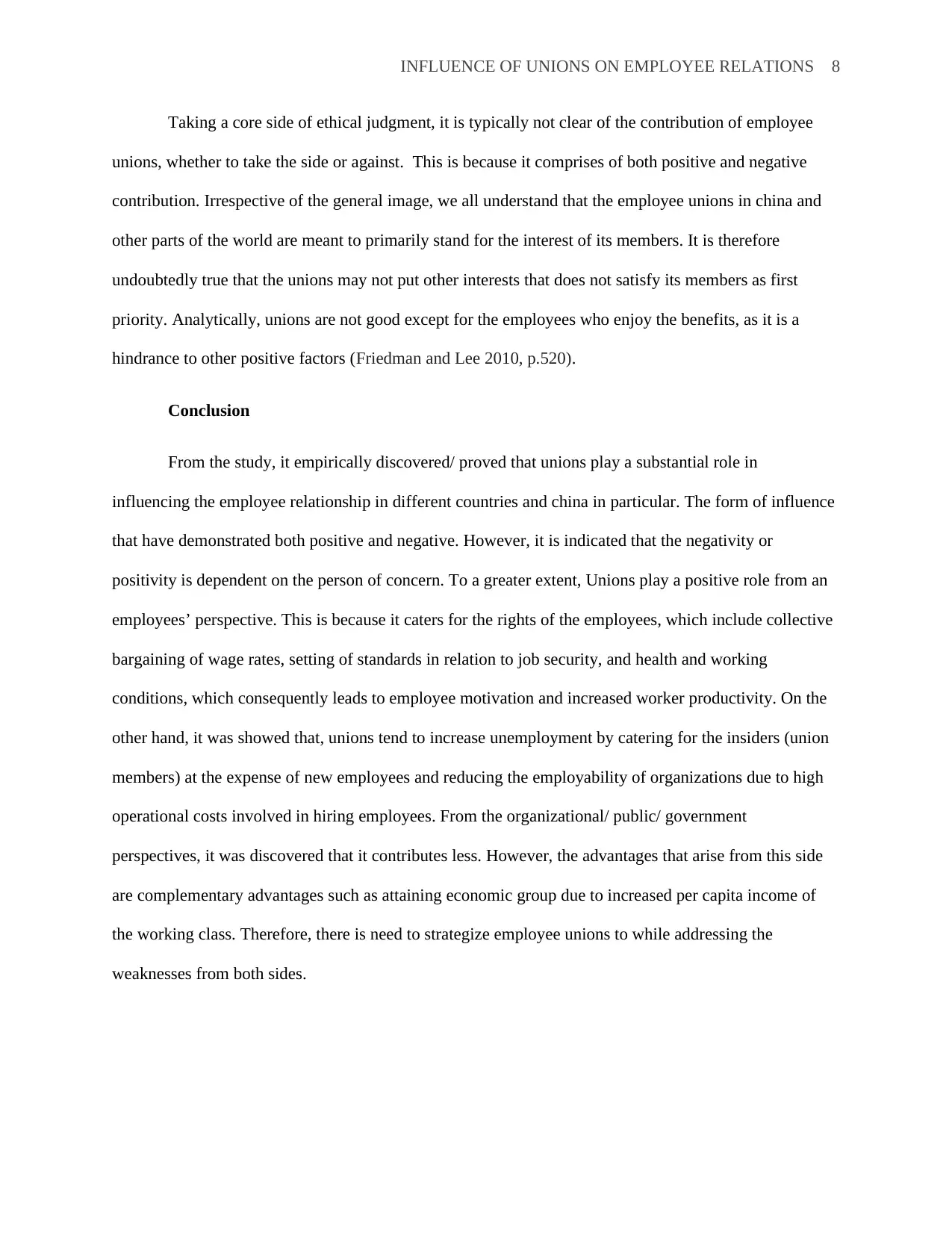
INFLUENCE OF UNIONS ON EMPLOYEE RELATIONS 8
Taking a core side of ethical judgment, it is typically not clear of the contribution of employee
unions, whether to take the side or against. This is because it comprises of both positive and negative
contribution. Irrespective of the general image, we all understand that the employee unions in china and
other parts of the world are meant to primarily stand for the interest of its members. It is therefore
undoubtedly true that the unions may not put other interests that does not satisfy its members as first
priority. Analytically, unions are not good except for the employees who enjoy the benefits, as it is a
hindrance to other positive factors (Friedman and Lee 2010, p.520).
Conclusion
From the study, it empirically discovered/ proved that unions play a substantial role in
influencing the employee relationship in different countries and china in particular. The form of influence
that have demonstrated both positive and negative. However, it is indicated that the negativity or
positivity is dependent on the person of concern. To a greater extent, Unions play a positive role from an
employees’ perspective. This is because it caters for the rights of the employees, which include collective
bargaining of wage rates, setting of standards in relation to job security, and health and working
conditions, which consequently leads to employee motivation and increased worker productivity. On the
other hand, it was showed that, unions tend to increase unemployment by catering for the insiders (union
members) at the expense of new employees and reducing the employability of organizations due to high
operational costs involved in hiring employees. From the organizational/ public/ government
perspectives, it was discovered that it contributes less. However, the advantages that arise from this side
are complementary advantages such as attaining economic group due to increased per capita income of
the working class. Therefore, there is need to strategize employee unions to while addressing the
weaknesses from both sides.
Taking a core side of ethical judgment, it is typically not clear of the contribution of employee
unions, whether to take the side or against. This is because it comprises of both positive and negative
contribution. Irrespective of the general image, we all understand that the employee unions in china and
other parts of the world are meant to primarily stand for the interest of its members. It is therefore
undoubtedly true that the unions may not put other interests that does not satisfy its members as first
priority. Analytically, unions are not good except for the employees who enjoy the benefits, as it is a
hindrance to other positive factors (Friedman and Lee 2010, p.520).
Conclusion
From the study, it empirically discovered/ proved that unions play a substantial role in
influencing the employee relationship in different countries and china in particular. The form of influence
that have demonstrated both positive and negative. However, it is indicated that the negativity or
positivity is dependent on the person of concern. To a greater extent, Unions play a positive role from an
employees’ perspective. This is because it caters for the rights of the employees, which include collective
bargaining of wage rates, setting of standards in relation to job security, and health and working
conditions, which consequently leads to employee motivation and increased worker productivity. On the
other hand, it was showed that, unions tend to increase unemployment by catering for the insiders (union
members) at the expense of new employees and reducing the employability of organizations due to high
operational costs involved in hiring employees. From the organizational/ public/ government
perspectives, it was discovered that it contributes less. However, the advantages that arise from this side
are complementary advantages such as attaining economic group due to increased per capita income of
the working class. Therefore, there is need to strategize employee unions to while addressing the
weaknesses from both sides.
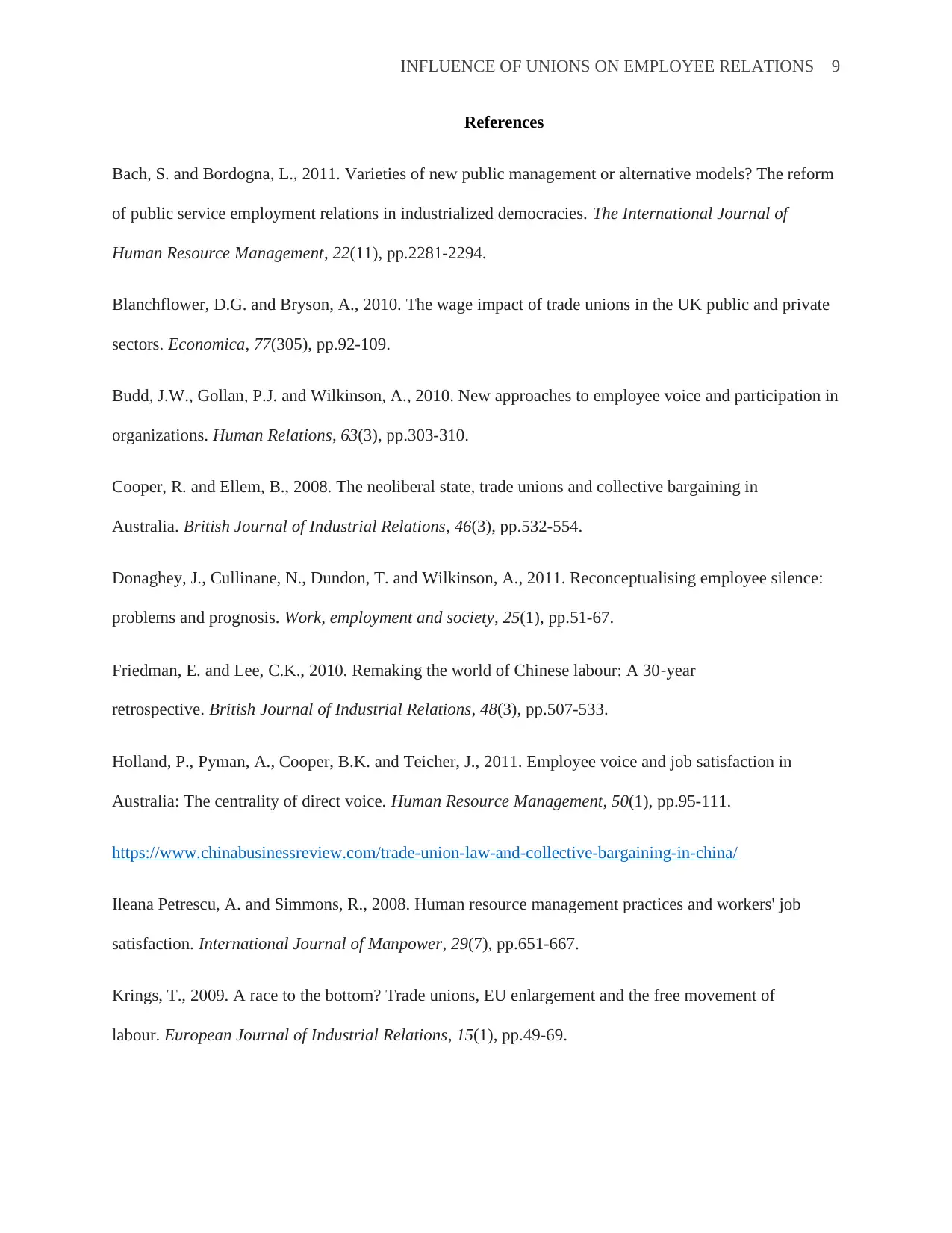
INFLUENCE OF UNIONS ON EMPLOYEE RELATIONS 9
References
Bach, S. and Bordogna, L., 2011. Varieties of new public management or alternative models? The reform
of public service employment relations in industrialized democracies. The International Journal of
Human Resource Management, 22(11), pp.2281-2294.
Blanchflower, D.G. and Bryson, A., 2010. The wage impact of trade unions in the UK public and private
sectors. Economica, 77(305), pp.92-109.
Budd, J.W., Gollan, P.J. and Wilkinson, A., 2010. New approaches to employee voice and participation in
organizations. Human Relations, 63(3), pp.303-310.
Cooper, R. and Ellem, B., 2008. The neoliberal state, trade unions and collective bargaining in
Australia. British Journal of Industrial Relations, 46(3), pp.532-554.
Donaghey, J., Cullinane, N., Dundon, T. and Wilkinson, A., 2011. Reconceptualising employee silence:
problems and prognosis. Work, employment and society, 25(1), pp.51-67.
Friedman, E. and Lee, C.K., 2010. Remaking the world of Chinese labour: A 30‐year
retrospective. British Journal of Industrial Relations, 48(3), pp.507-533.
Holland, P., Pyman, A., Cooper, B.K. and Teicher, J., 2011. Employee voice and job satisfaction in
Australia: The centrality of direct voice. Human Resource Management, 50(1), pp.95-111.
https://www.chinabusinessreview.com/trade-union-law-and-collective-bargaining-in-china/
Ileana Petrescu, A. and Simmons, R., 2008. Human resource management practices and workers' job
satisfaction. International Journal of Manpower, 29(7), pp.651-667.
Krings, T., 2009. A race to the bottom? Trade unions, EU enlargement and the free movement of
labour. European Journal of Industrial Relations, 15(1), pp.49-69.
References
Bach, S. and Bordogna, L., 2011. Varieties of new public management or alternative models? The reform
of public service employment relations in industrialized democracies. The International Journal of
Human Resource Management, 22(11), pp.2281-2294.
Blanchflower, D.G. and Bryson, A., 2010. The wage impact of trade unions in the UK public and private
sectors. Economica, 77(305), pp.92-109.
Budd, J.W., Gollan, P.J. and Wilkinson, A., 2010. New approaches to employee voice and participation in
organizations. Human Relations, 63(3), pp.303-310.
Cooper, R. and Ellem, B., 2008. The neoliberal state, trade unions and collective bargaining in
Australia. British Journal of Industrial Relations, 46(3), pp.532-554.
Donaghey, J., Cullinane, N., Dundon, T. and Wilkinson, A., 2011. Reconceptualising employee silence:
problems and prognosis. Work, employment and society, 25(1), pp.51-67.
Friedman, E. and Lee, C.K., 2010. Remaking the world of Chinese labour: A 30‐year
retrospective. British Journal of Industrial Relations, 48(3), pp.507-533.
Holland, P., Pyman, A., Cooper, B.K. and Teicher, J., 2011. Employee voice and job satisfaction in
Australia: The centrality of direct voice. Human Resource Management, 50(1), pp.95-111.
https://www.chinabusinessreview.com/trade-union-law-and-collective-bargaining-in-china/
Ileana Petrescu, A. and Simmons, R., 2008. Human resource management practices and workers' job
satisfaction. International Journal of Manpower, 29(7), pp.651-667.
Krings, T., 2009. A race to the bottom? Trade unions, EU enlargement and the free movement of
labour. European Journal of Industrial Relations, 15(1), pp.49-69.
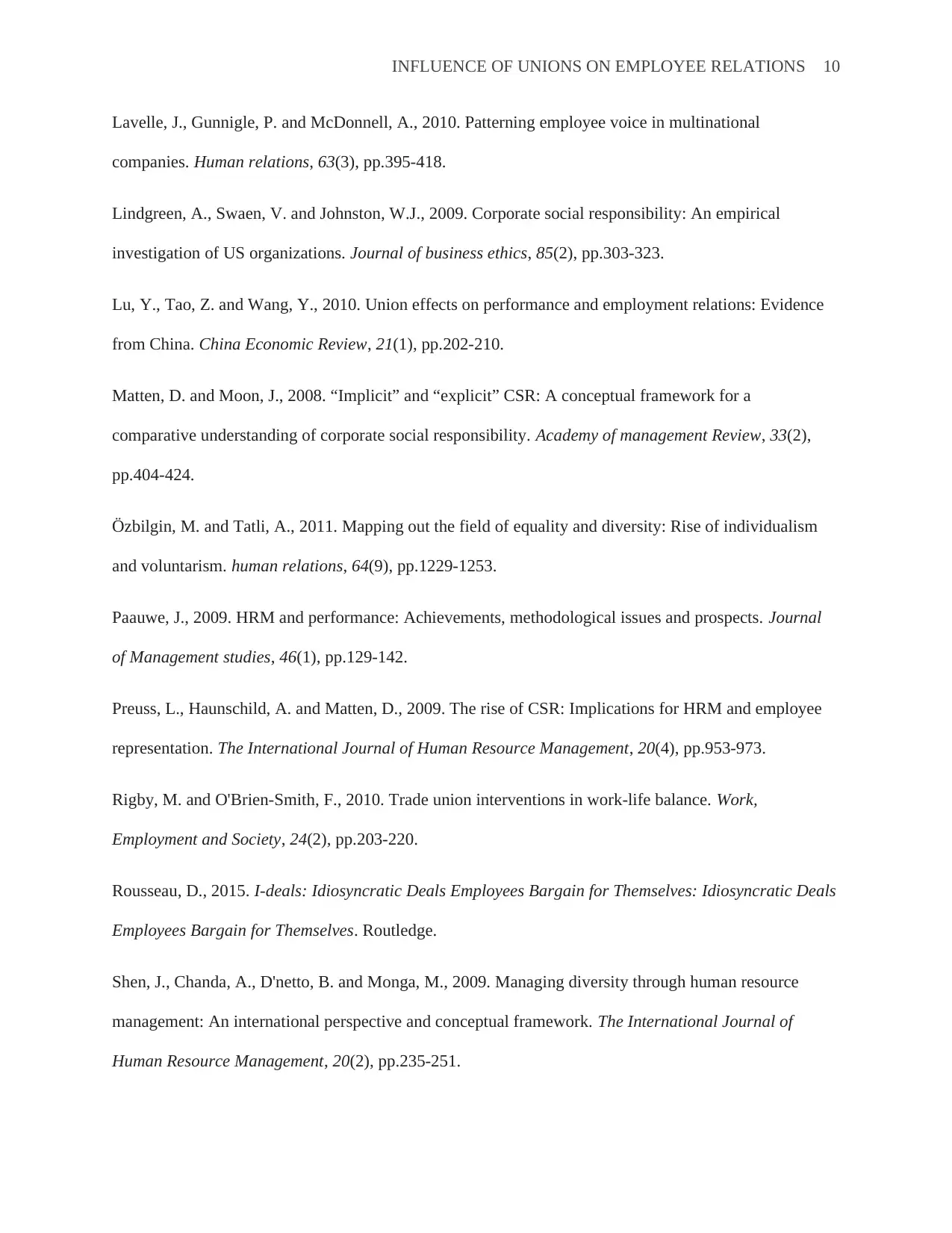
INFLUENCE OF UNIONS ON EMPLOYEE RELATIONS 10
Lavelle, J., Gunnigle, P. and McDonnell, A., 2010. Patterning employee voice in multinational
companies. Human relations, 63(3), pp.395-418.
Lindgreen, A., Swaen, V. and Johnston, W.J., 2009. Corporate social responsibility: An empirical
investigation of US organizations. Journal of business ethics, 85(2), pp.303-323.
Lu, Y., Tao, Z. and Wang, Y., 2010. Union effects on performance and employment relations: Evidence
from China. China Economic Review, 21(1), pp.202-210.
Matten, D. and Moon, J., 2008. “Implicit” and “explicit” CSR: A conceptual framework for a
comparative understanding of corporate social responsibility. Academy of management Review, 33(2),
pp.404-424.
Özbilgin, M. and Tatli, A., 2011. Mapping out the field of equality and diversity: Rise of individualism
and voluntarism. human relations, 64(9), pp.1229-1253.
Paauwe, J., 2009. HRM and performance: Achievements, methodological issues and prospects. Journal
of Management studies, 46(1), pp.129-142.
Preuss, L., Haunschild, A. and Matten, D., 2009. The rise of CSR: Implications for HRM and employee
representation. The International Journal of Human Resource Management, 20(4), pp.953-973.
Rigby, M. and O'Brien-Smith, F., 2010. Trade union interventions in work-life balance. Work,
Employment and Society, 24(2), pp.203-220.
Rousseau, D., 2015. I-deals: Idiosyncratic Deals Employees Bargain for Themselves: Idiosyncratic Deals
Employees Bargain for Themselves. Routledge.
Shen, J., Chanda, A., D'netto, B. and Monga, M., 2009. Managing diversity through human resource
management: An international perspective and conceptual framework. The International Journal of
Human Resource Management, 20(2), pp.235-251.
Lavelle, J., Gunnigle, P. and McDonnell, A., 2010. Patterning employee voice in multinational
companies. Human relations, 63(3), pp.395-418.
Lindgreen, A., Swaen, V. and Johnston, W.J., 2009. Corporate social responsibility: An empirical
investigation of US organizations. Journal of business ethics, 85(2), pp.303-323.
Lu, Y., Tao, Z. and Wang, Y., 2010. Union effects on performance and employment relations: Evidence
from China. China Economic Review, 21(1), pp.202-210.
Matten, D. and Moon, J., 2008. “Implicit” and “explicit” CSR: A conceptual framework for a
comparative understanding of corporate social responsibility. Academy of management Review, 33(2),
pp.404-424.
Özbilgin, M. and Tatli, A., 2011. Mapping out the field of equality and diversity: Rise of individualism
and voluntarism. human relations, 64(9), pp.1229-1253.
Paauwe, J., 2009. HRM and performance: Achievements, methodological issues and prospects. Journal
of Management studies, 46(1), pp.129-142.
Preuss, L., Haunschild, A. and Matten, D., 2009. The rise of CSR: Implications for HRM and employee
representation. The International Journal of Human Resource Management, 20(4), pp.953-973.
Rigby, M. and O'Brien-Smith, F., 2010. Trade union interventions in work-life balance. Work,
Employment and Society, 24(2), pp.203-220.
Rousseau, D., 2015. I-deals: Idiosyncratic Deals Employees Bargain for Themselves: Idiosyncratic Deals
Employees Bargain for Themselves. Routledge.
Shen, J., Chanda, A., D'netto, B. and Monga, M., 2009. Managing diversity through human resource
management: An international perspective and conceptual framework. The International Journal of
Human Resource Management, 20(2), pp.235-251.
Secure Best Marks with AI Grader
Need help grading? Try our AI Grader for instant feedback on your assignments.
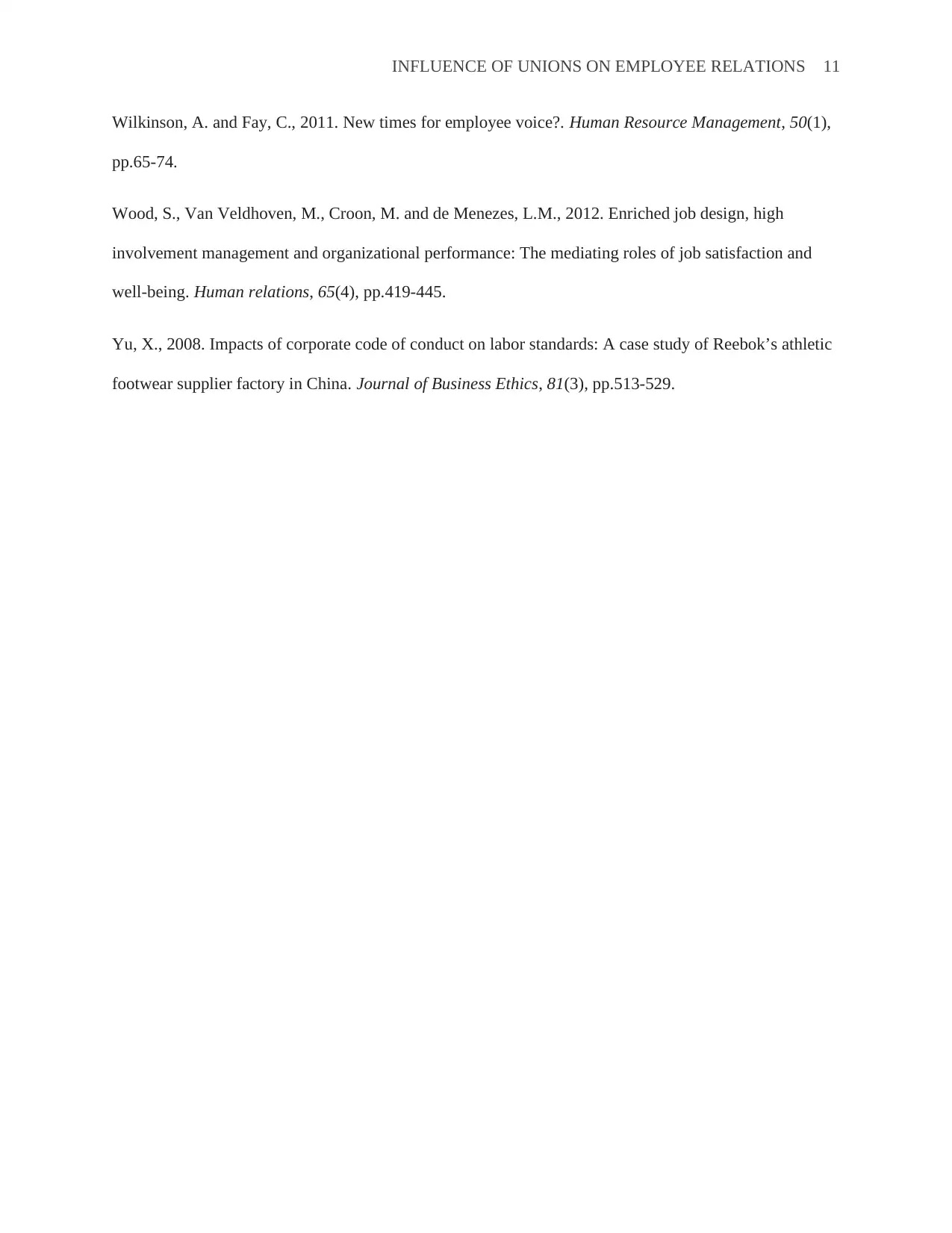
INFLUENCE OF UNIONS ON EMPLOYEE RELATIONS 11
Wilkinson, A. and Fay, C., 2011. New times for employee voice?. Human Resource Management, 50(1),
pp.65-74.
Wood, S., Van Veldhoven, M., Croon, M. and de Menezes, L.M., 2012. Enriched job design, high
involvement management and organizational performance: The mediating roles of job satisfaction and
well-being. Human relations, 65(4), pp.419-445.
Yu, X., 2008. Impacts of corporate code of conduct on labor standards: A case study of Reebok’s athletic
footwear supplier factory in China. Journal of Business Ethics, 81(3), pp.513-529.
Wilkinson, A. and Fay, C., 2011. New times for employee voice?. Human Resource Management, 50(1),
pp.65-74.
Wood, S., Van Veldhoven, M., Croon, M. and de Menezes, L.M., 2012. Enriched job design, high
involvement management and organizational performance: The mediating roles of job satisfaction and
well-being. Human relations, 65(4), pp.419-445.
Yu, X., 2008. Impacts of corporate code of conduct on labor standards: A case study of Reebok’s athletic
footwear supplier factory in China. Journal of Business Ethics, 81(3), pp.513-529.
1 out of 11
Related Documents
Your All-in-One AI-Powered Toolkit for Academic Success.
+13062052269
info@desklib.com
Available 24*7 on WhatsApp / Email
![[object Object]](/_next/static/media/star-bottom.7253800d.svg)
Unlock your academic potential
© 2024 | Zucol Services PVT LTD | All rights reserved.





